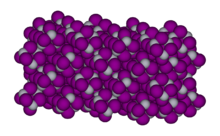يوديد الزئبق الثنائي
 يوديد الزئبق الثنائي (الصيغة α)
| |
 يوديد الزئبق الثنائي (الصيغة β)
| |
 الصيغتان α (يمين) و β (يسار)
| |
| الأسماء | |
|---|---|
| اسم أيوپاك
Mercury diiodide
| |
| أسماء أخرى | |
| المُعرِّفات | |
| رقم CAS | |
3D model (JSmol)
|
|
| ChEBI | |
| ChemSpider | |
| DrugBank | |
| ECHA InfoCard | 100.028.976 |
PubChem CID
|
|
| UNII | |
CompTox Dashboard (EPA)
|
|
| |
| |
| الخصائص | |
| الصيغة الجزيئية | HgI2 |
| كتلة مولية | 454.40 g/mol |
| المظهر | مسحوق برتقالي-أحمر |
| الرائحة | عديم الرائحة |
| الكثافة | 6.36 g/cm3 |
| نقطة الانصهار | |
| نقطة الغليان | |
| قابلية الذوبان في الماء | 0.006 g/100 mL |
| قابلية الذوبان | قابل للذوبان قليلاً في الكحول، ether, acetone, كلوروفورم، ethyl acetate, CS2, زيت الزيتون، castor oil |
| القابلية المغناطيسية | −128.6·10−6 cm3/mol |
| معامل الانكسار (nD) | 2.455 |
| البنية | |
| البنية البلورية | tetrehedral |
| علم الأدوية | |
| D08AK30 (WHO) | |
| المخاطر | |
تبويب الاتحاد الاوروپي (DSD)
|
سام جداً (T+) خطر على البيئة (N) |
| توصيف المخاطر | R26/27/28, R33, R50/53 |
| تحذيرات وقائية | (S1/2), S13, S28, S45, S60, S61 |
| NFPA 704 (معيـَّن النار) | |
| نقطة الوميض | غير قابل للاشتعال |
| مركبات ذا علاقة | |
أنيونات أخرى
|
فلوريد الزئبق الثنائي كلوريد الزئبق الثنائي بروميد الزئبق الثنائي |
كاتيونات أخرى
|
يوديد الزنك يوديد الكادميوم |
مركـّبات ذات علاقة
|
يوديد الزئبق الأحادي |
ما لم يُذكر غير ذلك، البيانات المعطاة للمواد في حالاتهم العيارية (عند 25 °س [77 °ف]، 100 kPa). | |
| مراجع الجدول | |
يوديد الزئبق الثنائي Mercury(II) iodide هو مركب كيميائي صيغته الجزيئية: HgI2. وعادةً ما يُنتج اصطناعياً ولكن يمكن أيضاً العثور عليه في الطبيعة في شكل المعدن فائق الندرة coccinite. وعلى العكس من كلوريد الزئبق الثنائي القريب منه، فإن يوديد الزئبق الثنائي هو بالكاد قابل للذوبان في الماء (<100 ppm).
. . . . . . . . . . . . . . . . . . . . . . . . . . . . . . . . . . . . . . . . . . . . . . . . . . . . . . . . . . . . . . . . . . . . . . . . . . . . . . . . . . . . . . . . . . . . . . . . . . . . . . . . . . . . . . . . . . . . . . . . . . . . . . . . . . . . . . . . . . . . . . . . . . . . . . . . . . . . . . . . . . . . . . . .
انتاجه
يُنتج يوديد الزئبق الثنائي بإضافة محلول مائي من يوديد الپوتاسيوم إلى محلول مائي من كلوريد الزئبق الثنائي مع التقليب؛ الراسب يُؤخذ بالترشيح، ثم يُغسل ويُجفف بدرجة حرارة 70 °س.
- HgCl2 + 2 KI → HgI2 + KCl
الخصائص
يوديد الزئبق الثنائي لديه خاصية التلون الحراري؛ when heated above 126 °C (400°K) it undergoes a phase transition, from the red alpha crystalline form to a pale yellow beta form. As the sample cools, it gradually reacquires its original colour. It has often used for التلون الحراري demonstrations.[1] A third orange form is also known; this can be formed by recrystallisation and is also metastable, eventually converting back to the red alpha form.[2] The various forms can exist in a diverse range of crystal structures and as a result mercury(II) iodide possess a surprisingly complex phase diagram.[3]
الاستخدامات
Mercury(II) iodide is used for preparation of Nessler's reagent, used for detection of presence of ammonia.
Mercury(II) iodide is a semiconductor material, used in some x-ray and gamma ray detection and imaging devices operating at room temperatures.[4]
In veterinary medicine, mercury(II) iodide is used in blister ointments in exostoses, bursal enlargement, etc.[بحاجة لمصدر]
It can appear as a precipitate in many reactions.
انظر أيضاً
- Mercury(I) iodide, Hg2I2
الهامش
- ^ Thermochromism: Mercury(II) Iodide. Jchemed.chem.wisc.edu. Retrieved on 2011-06-02.
- ^ SCHWARZENBACH, D. (1 January 1969). "The crystal structure and one-dimensional disorder of the orange modification of HgI2". Zeitschrift für Kristallographie - Crystalline Materials. 128 (1–6). doi:10.1524/zkri.1969.128.16.97.
- ^ Hostettler, Marc; Schwarzenbach, Dieter (February 2005). "Phase diagrams and structures of HgX2 (X = I, Br, Cl, F)". Comptes Rendus Chimie. 8 (2): 147–156. doi:10.1016/j.crci.2004.06.006.
- ^ Simage, Oy U.S. Patent 6٬509٬203 Semiconductor imaging device and method for producing same, Issue date: Jan 21, 2003
